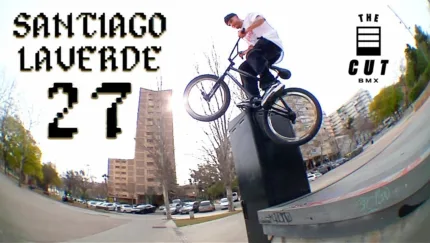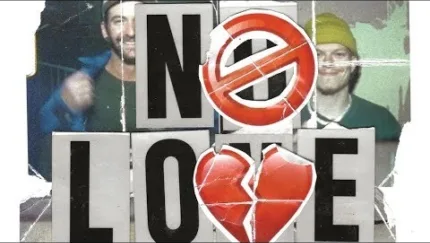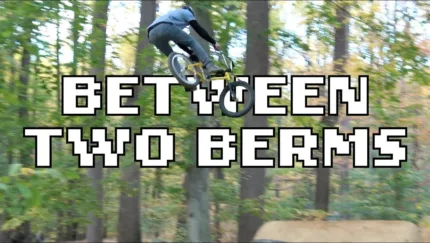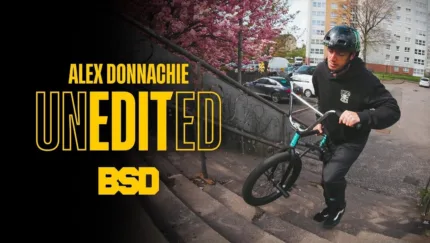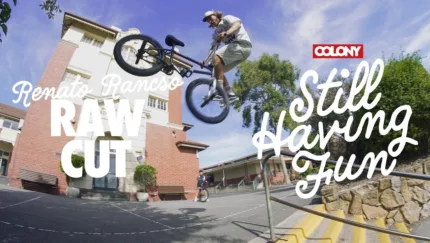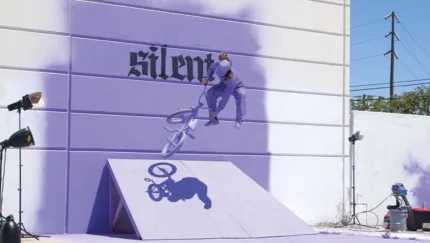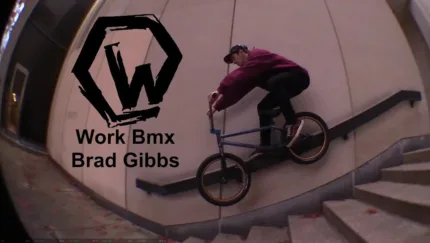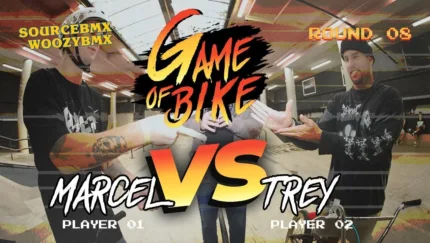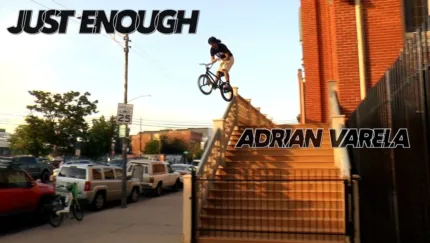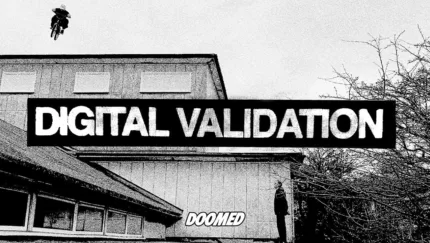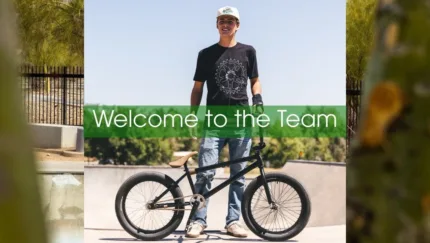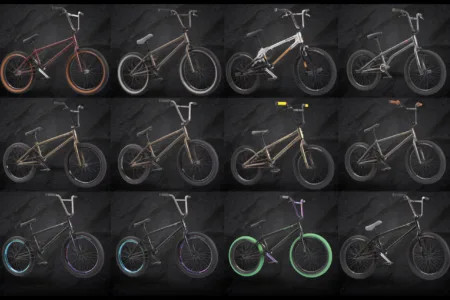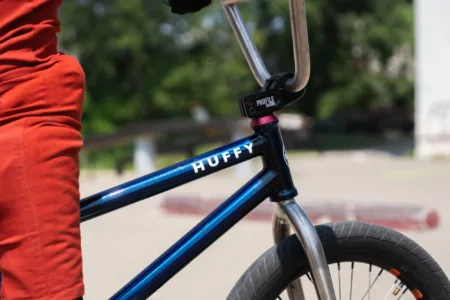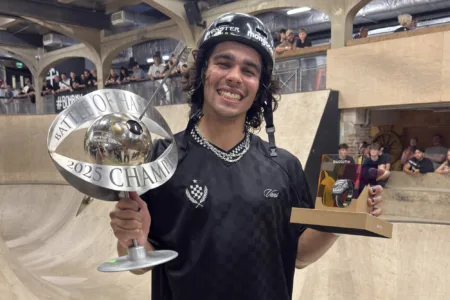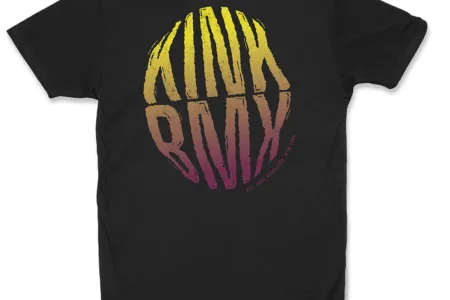
Garrett Byrnes And Fingers Crossed
The suspension concept returns...
8 May 2020

Words and photos by Rob Dolecki
Back in the early to mid 70s during BMX's infancy when all types of bike designs started popping up, a few of the first BMX-specific bikes had suspension. It's not really that surprising, though, since it all began from kids in dirt lots mimicking motocross. Maybe it was gimmickry, maybe it was genuinely theorized that suspension might be a valuable addition on some of the wild downhill race courses of the era. Either way, it became apparent very quickly that the double diamond hard tail frame design and rigid forks were the way to go. Suspension, for all intents and purposes, didn't really help on a BMX track, and for the next two decades, vanished almost as quickly as it appeared.
Then came the early 90s and Answer introduced a product called Pro Forx. Despite the fact the BMX tracks were more groomed and smoother than at any other time in prior history, they decided to release a 20" suspension fork and pay some pro racers a few hundred bucks a month to run them. With one small mod (using PVC to replace the elastomer so there was no travel, effectively making them a rigid fork) to their forks, you had a dozen or so dudes cashing in on Answer, and Answer cashing in on countless impressionable kids who didn't see through a fad that was all contrived anodized purple fashion and no function. Within a year or two, that sector of the racer population finally caught on to the ruse, and suspension once again seemed to vanish from the BMX world.
Enter Ruben Alcantara. After riding downhill at Whistler, B.C. on an MTB in the mid 2000s, the wheels had started turning in that innovative brain of his, and he had an idea to make a BMX bike that could work on the same trails at similar speeds of the bigger full-suspension bikes. Once Ruben showed Garrett Byrnes photos of his creation, Garrett embarked on a mission to build his own version in order to take advantage of new terrain.
The end result is their combined effort called Fingers Crossed. While both Ruben and Garrett have had interviews about the project in other outlets, we decided to take an in-depth look into Garrett's build, as well as conduct a detailed interview with him about the whole project.
The once ostracized concept of suspension has returned to the BMX realm, but this time around, it's not about some gimmickry = revenue formula. It's via the brainchild of two of the most legendary and innovative riders to ever grace a bike, and for no reason other than to expand the terrain possibilities for 20-inch BMX bikes, namely downhill MTB trails, on a familiar-feeling two wheeled machine. With uber-creative minds like Ruben and Garrett on the the case, it will be interesting to see where it evolves to.
Check out Part 2 of this article here, where we asked a few select people (most of whom are primarily on the older end of the age spectrum, since that is what these bikes are somewhat more geared for) their views of suspension on BMX bikes.


GARRETT BYRNES
Explain the beginnings of the bike concept.
It started with Ruben riding downhill mountain bikes in Whistler, Canada in 2005 or 2006. He came home, decided to build his own dual-suspension BMX bike. He cut up an old GT Box series race frame, and built a two-piece, front half chromoly, back half aluminum, with a swing arm pivot rear suspension, and front suspension forks. He rode that for a while and sent me photos. He kind of let it die, because his body was able to ride a normal bike. He had a lot going on - at the time he was reinventing BMX.
Yeah, that was during the “Grounded” era.
So this was a side project; he always has some kind of side project going on. He rode motocross a lot at the time too, which I’m sure was an influence. It resurfaced again 2015,16,17 to now, where he was thinking about it again. His buddy Ari and him went to his little shop in Malaga, and they pieced together a dual-suspension BMX bike and started messing around with different terrains. He’d send me photos, and progressively it moved; it was almost chapters of a book getting written. By the end, I was like, “I need to make one of these.” This is exactly the type of thing I needed to do, because riding with my son Noah in the woods with my 20” bike and try to chase him with no suspension. It was so rigid. Now I could try and make my own version of Ruben’s bike to work for my benefit.
How did Fingers Crossed come about?
Throughout this whole process, of Ruben developing his bike as full-suspension, and later me developing this bike more based off a regular BMX frame, we were constantly sending videos back and forth, almost daily. We were feeding off each other. We had to see how these bikes work; we decided to take a trip to Malaga, and then Revolution Bike Park in England. The whole premise behind the Malaga trip was “I hope this works, fingers crossed.” We would always say that. Hopefully we don’t break these forks, hopefully the frame holds together, hopefully the airline doesn’t lose our bikes because we don’t have any other bikes like this. Fingers crossed was our feeling the whole time. We went to Malaga and everything worked how we hoped, and we couldn’t have been happier. We went to England, it rained two out of three days we were there, and we were still able to ride everything we wanted and more, and everything worked once again. To this day we’re still saying fingers crossed, because everything’s worked so far, but we’re waiting to find a catch to what didn’t work. We’ve had three different sets of forks that we’ve been trying, we have a lot of things that we trade in, trade out, but for the most part our fingers crossed is hoping we can move forward with the progression of this project. Now it’s traveling and creating trips based on these bikes to see what the possibilities are, and bring our friends into it.
Tell us about the geometry.
This is a 21 ¼" T-1 SFA. The only add-ons are the dropout slots and tabs for disc brake.
What were some of the experiments to figure out frame geometry?
You could probably just put a suspension fork on, and have an extremely slack head tube angle. You would probably have to figure out a way to be comfortable with the bars higher. I talked to my friend Mike Maloney, and he created an insert for the dropout that would make my frame an inch longer and an inch lower, to make it feel somewhat more like a BMX bike. It also allowed the disc brake to be mounted on the dropout. It was a simple fix that made it feel exactly how I wanted the bike to feel. The bottom bracket looks extremely high, especially with the bash guard. At first I was not even thinking about it. Most of the time you’re riding downhill or you’re riding with pressure on the front fork. So you are already bringing the BB an inch lower. I decided to come up with a new version of the frame with the BB an inch and a ½ lower. It feels natural the way it rides.
Why is that?
More room, so you are more comfortable, and stability in the back. Once you get over like 25 mph going downhill going over rock, the more back-end you have the more stable it is. I’ve gone about 40-45 mph straight downhill on this bike with rock and loose gravel, and I haven’t felt sketchy on it at that speed.
Why disc brakes?
They are a no-brainer, because as soon as there is any wetness with 990s, you more or less lose your brakes. In the woods you are always dealing with mud or something, and you have greater speed and need braking power. Also with any mountain bike park, you need front and rear disc brakes, so you can go to any park in the U.S.with this. Plus with the progression of slope style bikes, it’s going closer towards BMX trails. Now you can take a BMX bike and ride similar stuff where you couldn’t have before.
What terrain does this bike work on for you?
This bike opens up a whole new arm of riding. You have vert, dirt, street, all these different categories. This bike is a new one, where you can ride in the woods, and places I would have never ridden my BMX bike, and places I would have never been allowed to ride on my BMX bike. You probably could ride some trails with it, but I like my original BMX bike for trails; you’re not going to ride vert or street with this.
It’s a vehicle for new terrain.
It will never replace my normal BMX bike; it’s merely a different type of BMX bike.

How does it feel going back to a regular rigid BMX bike after riding this?
By your third pedal down the street, you don’t even really notice. I’ve switched back and forth so many times. The rigidity of a regular bike you definitely notice. It’s harder on your body. This bike is extremely easy on your body, flexing in every direction all the time. Ruben has a hurt back, and can ride this bike for five times as long as a normal bike. Maybe some people can get back into riding again because this bike, other people can transition to riding this that don’t want to ride normal trails, but still want to ride a BMX bike.
Who do you think will enjoy this bike?
I think anyone can enjoy this bike that enjoys riding a 20-inch bike. You have to open your mind a little bit; you can feel like a little kid. Monster truck over curbs, go in the woods and ride through mud puddles and brakes still work. You can do whatever you want; it’s open for your interpretation of what you want it to be. I just ask people to have an open mind and try it. I’m not saying anyone should change what they ride because of it, but maybe add this on to how you ride, and ride twice as much, in places you would have never thought about riding before.
What’s up with the forks?
Everything dimension-wise that scientifically works on a BMX was done over experience of many years. Right now these dimensions are pretty different. In the future we’ll probably have better dimensions. These forks allowed us to just put them on the bike and see how it goes. And each time we learned a little more along the way. At the end of the day everything works, just some things work better.
What are the modifications?
The dropout tabs welded into the existing dropouts. It was pretty easily done, and turned a regular BMX bike into this downhill version, because it lengthened the rear end, and gave tire clearance. Plus the tabs for disc brakes. You can get 20" mountain bikes forks anywhere. But you want to get the high end ones with the through axle, and a little bit heavier arms on the forks. If you’ve ridden BMX for a long time, you can kind of gauge how forks should feel, and figure it out as you go. My version and Ruben’s version are extremely different, so the next person’s version might be different than what we have also.
Weight?
I would say not so heavy to borderline almost heavy. (Laughter) Ruben and I laugh because we get all these tech questions, and neither of us have weighed or measured anything. That’s generally how we’ve done this whole project. It’s been working well.
What’s special about the hubs?
They are Profile Elite BMX disc hubs. I talked to Matt Coplon, and he was pretty excited on the project. He was really great with helping us out with the hubs. I’ve ridden a Profile hub on my bike probably for the last 20 years. Out of those 20 years, I think I’ve only had like two hubs. That’s enough for me to keep going with that company, because they always put out such a quality product that lasts such a long time. These hubs are just a disc version. You can actually get these hubs if you want to have a BMX bike and have a disc brake, or not- you can take the disc off and still ride the same hub.
How did the bash guard come about?
I’ve always loved bash guards. I talked to Mike Maloney, and in true Mike fashion, he had something a few days later and handed me a piece of plastic. It was water-cut out to a perfect bash guard. It fit on perfect. I use it a lot to get over things. I’m looking for a perfect log to slide down. It’s a cool extra piece to have on it, and looks cool.
How did you find the right 20-inch tires?
We went through quite a few different tires. The first version, we built wheels with 19” unicycle rims and Maxxis tires, because that was the only tire that existed that was wide enough for what we wanted to do. By the time I finished the first version of my bike, there were 20” mountain bike tires that had come out. So we scrapped the 19” wheels, and we moved to regular 20” rims, and Kenda Chaos tires. Maxxis also makes a similar tire. Front tire is a 2.8, and the back tire is a 2.6. I like the bigger tires because it’s more cushion; at a higher speed it’s easier to control yourself. I run about 40 PSI in the front and between 45-50 PSI in the rear. There’s plenty of suspension just within the tires.
Has it been just you and Ruben funding it?
Yeah, we fund it all on our own right now. It would be awesome if we could get a sponsor, because we could then do it more freely, easily, and faster. Right now, it’s months of saving and figuring out when we have free time that would align; you have to be patient and wait, which is the cool thing.
Talk about the next bike build.
I want to make a new version. Mike and I came up with a new design. The new version is a 22” top tube, along the same lines as an SFA geometry, with a 1 ½” lower BB, and an inch higher stand-over, and an inch longer rear end.
What have mountain bikers’ reaction been?
They are hilarious. Most of the mountain bikers are BMXers that turned into mountain bike riders. They see this bike, and it’s like their dream bike. They can get a piece of their younger reality back. They take it for a ride and they have ten-year old huge eyes. Some guys write it off and others embrace it. It’s always worth giving something new a try.
Whenever you show up somewhere everyone is looking at it and judging it instantly. I’ve ridden so many different bikes over the years. I’ve ridden bikes that work great, and ones that don’t. I’d say just keep an open mind. 15 years ago, I might have tired it and not given it a chance. But Now that I’ve gotten older and realize so many versions of BMX can be fun that in the past we’ve written it off, that this is something I would totally give more time to because I’ve had so much fun with it. Thanks to Profile, T-1, Mike Maloney, Belmar Bike Shop for helping figure out how to run disc brakes. And thanks to Ruben for creating this bike in the first place. Who knows what it will turn into; if it turns into nothing, either way I got to ride a ton of cool places with a bunch of cool people.
2020 plans?
Ruben and I have been going back and forth with ideas with these bikes. We are both extremely busy so we don’t really have enough time to start a bike company, or have much time to ride them. Our main goal is to just ride them as many places as we can and have fun doing it. With the Fingers Crossed project, be able to take them around the world and take them to places we would like to ride with the people we want to ride with.

SPECS OF GARRETT'S BIKE:
Frame: Terrible One SFA 21 ¼” TT
Fork: Little Shredder 20” downhill fork. We also had a samples from Taiwan, and the latest one is a 20” Manitou- by far the best fork we’ve had. It’s the heaviest version; I’m waiting to use that on my new bike.
Bars: T-1 8.85” rise
Grips: An ergo grip; Specialized makes them
Stem: S&M Credence
Seat: Fly Bikes
Seat Post: Fly Bikes
Cranks: Fly Bikes
Sprocket: DRG Machine 33T
Pedals: DMR
Chain: Odyssey
Hubs: Profile Elite Disc BMX hubs 13T cog
Tires: Kenda Chaos tires. Front tire is a 2.8, and the back tire is a 2.6
Brakes: SRAM Disc

MIKE BENNETT
We also caught up with friend of Ruben's and early suspension adaptor, Mike Bennett about his connection with the project. Interview by Ste Jones.
Did you come up with this independently of Ruben and Garret? Was it a happy coincidence that they were also making bikes like this?
No it’s all Ruben’s gig. I lived in Spain for about seven years and met Ruben out there and we became good friends and then rest is history really. He mentioned it to me a while back and I jumped on board and planned the Wales trip.
Do you find these bike easier to ride?
Well, it’s way easier on your body.
Is it not quite sluggish?
Not really. Like when we rode Revolution [MTB bike park in Wales] it started raining and we were getting away with it. Like Garret was literally just riding in the rain.
Can you talk us through the bike? What forks are you running?
I think the brand’s called Spinner. I think Ruben got them from China just for the first leg of the trip and then we found that Manitou do a fork and Ruben’s got a pair. They sell them at Chain Reaction over here but I’m yet to buy a pair.
Is there a weight limit on them?
There’s a weight limit on the Chinese ones we got and we just absolutely hammered them.
What tyres are you running?
I think I’ve got a Kenda 2.8 on the front and I’ve actually got a unicycle 2.5 on the back. I know you can run a 2.6 on the back with a disc brake but I’ve still got my regular BMX brakes, so I’ve got a U-brake on the back. But my new frame will have a disc mount.
Yeah I heard that Ted James is building you a frame. How’s it going to be different?
Slightly longer top tube, longer back end, obviously disc mounts, but it’s not going to be drastic. You’ve got to change the geometry to take the forks into account, so you’ve got to change the head angle a little bit, but it’ll still feel like a regular BMX, with 20in wheels.
Has it made a huge difference to your riding or is it more just a fun project to have on the side?
Yeah, I mean I broke my hip in October 2018 at an indoor skatepark and I kind of crept back into riding for a little bit and then this idea came out and we kind of ran with it and I’m almost 100% now, so ready to go. Ready to hammer these bikes! (laughs)
How does it compare to other options like 22in bikes?
Yeah, I think it’s do-able on those as well. I was speaking to a guy who’s got a 22in and he’s struggling finding bigger tyres and stuff and we were talking about just putting 20in wheels on and then he’d have loads of clearance for the big 20in tyres, so it’d kind of ride the same but he’d have a longer frame.
How about just a rigid fork but with massive clearance?
Yeah, that’s another option. Garret has a set of Pitchforks that his friend welded a disc mount to. So I think just playing around with it. I rode a massive bowl the other day with it and it felt alright even with the massive tyres on. I mean it felt a little sluggish but still good.
So the next step for you is to get this new frame from Ted?
Yeah, and I’m going to order some new forks. I’m going to get those Manitous.
How much has it cost to put the whole thing together?
Not that much. Like the biggest cost is obviously the frame (if you’re going to buy a new frame), but apart from that, Garret gave me the back tyre and the forks were only like £100 and the disc brakes were cheap. So not mountain bike money!
Related Video
Fingers Crossed - Episode 1
Ruben and Garrett talk shop about their new project... - More Info
Related Video
FINGERS CROSSED - EPISODE TWO
Ruben and Garrett bomb some mountains in Malaga... - More Info
Related Video
FINGERS CROSSED - EPISODE 03
More action from the UK mountains with Ruben and Garrett... - More Info
Previous
Product Drop: Sunday 2021 Complete BIkes
Shipping out now!
Next
Is this a good thing for BMX? What People are saying about Fingers Crossed.
Hear the thoughts of Joe Rich, Cody Diggs & more...
Related Content
















